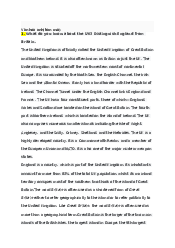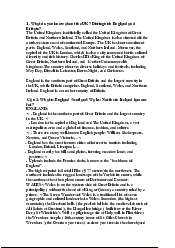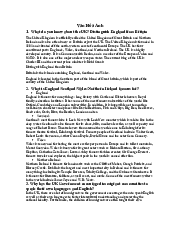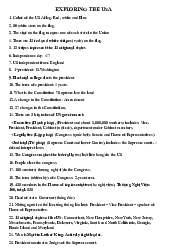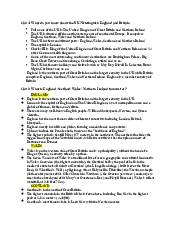






































































































































Preview text:
DIVISION OF LITERATURE & CULTURE Table of Contents
The United Kingdom......................................................................................... 1
People and Language....................................................................................... 19
Some Important Events in British History.....................................................31
Government.................................................................................................... 42
Education........................................................................................................ 60
Religion............................................................................................................ 74
Families and Family life.................................................................................. 82
Food and Drink............................................................................................... 86
Houses in Britain............................................................................................ 96
Media............................................................................................................. 100
Sport............................................................................................................... 108
Music............................................................................................................... 114
Holiday............................................................................................................ 119 COURSE OUTLINE Course Name: British Culture No. of Credits: 2 Course Length:
30 periods/ 15 classes/ 15 weeks
Course Prerequisites: None Course Objectives:
This course aims to equip learners with basic understanding of unique characteristics of
indigenous people from four nations of the UK and their native language. This course
also provides learners with opportunities to acquire various aspects in British culture
regarding education, politics, religion, family life, festivals and entertainment
throughout the British history, while exposing students more intensively with
experience for improved independent and collaborative learning through pair and group assignments.
Course Learning Outcomes
Upon completing this course, learners will be able -
IDENTIFY the facts about Britain and four constituent nations in terms of
geographical features, politics, education and religion; -
EXPLAIN the diversity of Britain in terms of people, language ecology, media, sports and entertainment; -
COMPARE different aspects of British culture with learners’ own cultures; -
FOSTER skills of thinking critically and working individually and effectively in a
team to handle assignments relating to British Culture.
Teaching and Learning modes
Teachers will conduct mini-lectures as whole class activities. Learners are to work in
groups on problem-solving tasks and translation practice. Through this course, learners
will be able to work collaboratively and independently with authentic materials and
acquire enhanced competency in British cultural issues. Course Assessment On-going Assessment 50% o
Attendance and In-class participation 10% o Role-play 10% o Presentation (Group Project) 30% o
End-of-term Assessment (Final Written Test) 50% THE UNITED KINGDOM Full name
The United Kingdom of Great Britain and Northern Ireland Capital London Major languages
English, Welsh, Scottish Gaelic, Irish Gaelic
Type of Government Queen
Constitutional monarchy Prime Minister
Elizabeth II Gordon Brown Establishment 1801 Area
242,514 km2 (93,638 sq miles) Population
63,182,178 million (National Statistic, 2011) Currency
Pound sterling (£) (GBP)
Royal Coat of Arms of the United Kingdom 1
The United Kingdom is officially called the United Kingdom of Great Britain and
Northern Ireland. It is also often known as Britain or just the UK.
The United Kingdom is situated off the north-western coast of continental Europe. It is
surrounded by the North Sea, the English Channel, the Irish Sea and the Atlantic Ocean. It
only has a land border with the Republic of Ireland. The Channel Tunnel under the English
Channel links England and France. .
The UK has four constituent parts, three of which—England, Wales and Scotland are
located on the island of Great Britain. The fourth part is Northern Ireland, which is located on
the island of Ireland. The UK also comprises numerous smaller islands including the Isle of
Wight, Anglesey, and the Scil y
ỉ , Orkney, Shetland, and the Hebrides.
The UK is a highly developed country. It is a Commonwealth Realm, and a member of
the European Union and NATO. It is also one of the major nuclear weapon states.
Write T for true and F for false. Correct the false statements 1. ……………………
The other names of the United Kingdom of Great Britain and
Northern Ireland are Great Britain and the UK. 2. …………………….
Britain is a member of EU and NATO. 3. …………………….
The UK is situated north-east of the European continent. 4. ……………………..
The UK is surrounded by the Pacific Ocean. 5. …………………….. It has border with Ireland. 6. ……………………..
The UK is a developing country. 7. ……………………..
It is a nuclear weapon country. 8. ……………………..
Great Britain comprises England, Wales, and Scotland 9. ……………………..
The United Kingdom comprises Great Britain and Ireland. 10. ……………………..
The Channel Tunnel links the UK with France. GOD SAVE THE QUEEN
God Save the Queen is the British national anthem. It is not known who wrote the
words or the music, but it was already a traditional song in the 18th century. The song has
several verses, but usually only the first verse is sung: 2
God save our gracious Queen,
Long live ournoblé Queen, God Save the Queen. Send her victorious, Happy andglorious, Long to reign over us; God Save the Queen.
(If the country has a king at the time, the word ‘Queen’ is, replaced by ‘King’) NATIONAL FLAGS Flag Date Use Description Union Flag, also
A superposition of the Flags of 1801 - known as the Union England, Scotland, arid St present Jack Patrick's Flag of Ireland Flag of England, also A red cross on a white field known as the St
This cross is the cross of Saint C1300 George's Cross
George, who is the patron saint of England. ... Flag of Scotland, also
A white saltire on a blue field known as the St C900 Andrew's Cross, and the Saltire Flag of Northern A red cross on a white field
Ireland, also known as defaced with a red hand, 1924 the Ulster Banner
crowned on a six pointed white star (representing the six counties in Northern Ireland) Flag of Wales, also A red dragon, passant, on a known as the Red green and white field 1959 Dragon or Y Ddraig Goch THE UNION JACK 3
CLOZE: Choose one appropriate word from the box below to complete each blank space. people Scotland united Wales diagonal celebrations loyally England public Ireland dragon British royal
The national flag of the United Kingdom is commonly known as the Union Jack and also
as the Union Flag. It has been Used as the (1)…………….. flag since 1603, when Scotland and
England were (2) …………….. The original design combined the red cross of (3) …………….. St
George’s Cross, with the white (4) ……………..cross on a blue background of (5) …………….., St
Andrew’s Cross. The red diagonal cross of (6) …………….. St Patrick’s cross, was added in 1801,
when Ireland became part of the United Kingdom. (7) …………….. is not represented on the
Union Jack because it is a principality of England. The red (8) …………….. of Cadwallader, which
is now often used as the national flag of Wales, dates from the 1950s.
The Union Jack is most often seen flying from (9) ……………..buildings or at sports
events. Children may wave small Union Jacks when a member of the (10) …………….. family
visits their town. During national (11) …………….. strings of small flags are hung across the street as bunting.
The Union Jack is less important to British (12). …………….. than the Stars and Stripes is 4
to Americans. Many people feel a stronger (13).. …………….. to the national flags of England,
Scotland, Wales or Northern Ireland. The flag of the European Union, a circle of gold stars on
a blue background, is sometimes also seen in Britain, e.g. on car number plates.
(Source: Oxford Guide to British and American Culture)
Mountains of the United Kingdom
The ten tallest mountains in the UK are all found in Scotland. The highest peaks in each part of the UK are:
Scotland: Ben Nevis (Nevis Range, 1,344 metres)
Wales: Snowdon (Cambrian Mountains, 1,085 metres)
England: Scafell Pike (Cumbrian Mountains, 977 metres)
Northern Ireland; Slieve Donard (Mourne Mountains, 852 metres) Rivers and lakes
The longest river in the UK is the River Severn (220 miles, 354 km) which flows through both Wales and England.
The longest rivers in the UK' are:
England: River Thames (215 miles, 346 km)
Scotland: River Tay (117 miles, 188 km)
Northern Ireland: River Bann (76 miles, 122 km)
Wales: River Towy (64 miles, 103 km)
The largest lakes in the UK are:
Northern Ireland: Lough Neagh (147.39 sq mi)
Scotland: Lodi Lomond (27.46 sq mi)
England: Windermere (5.69 sq mi) Wales: Lake Vymwy (3.18 sq mi)
The deepest lake in the UK is Loch Morar with a maximum depth of 309 metres (Loch
Ness is second at 228 metres deep). The deepest lake in England is Wast Water, which
descends to 79 metres (258 feet). British industry 5
Britain used to have many manufacturing industries, bự since-the Second Worid War it
is service industries especially banking and relating, which have expanded. About 70 percent
of people now work in service industries, including tourism, insurance, computer technology
and relating. Less than 30 percent of people have jobs in industry.
Heavy industries like steel manufacture and shipbuilding have been replaced by high-
technology manufacturing industries such as airplane engines and pharmaceuticals. Made in Britain
In Britain, there are only a few successful large companies, but many- successful small
companies. The large companies often invest a lot of money in research and development, R
& D, to find new and better, usually high-technology, products.
Successful small manufacturing companies in Britain often make expensive products.
These companies are successful because they use first-class materials, have excellent quality
control and the workers are proud of what they make. They include J, Barbour & Sons, which
makes waterproof jackets; Morgan Company, which makes elite cars; Quad Electro acoustics,
which makes top- quality hi-fi equipment; Wilkin & Sons, which makes jams.
Do the following people work in a service industry or a manufacturing industry? sale assistance aircraft factory worker insurance salesperson travel agent
research chemist for a drugs company bank cashier
Britain and the Commonwealth
Because it is an island, Britain has always forced to trade with other countries. During
the nineteenth century, Britain traded all over the world and had a large empire overseas.
The Commonwealth is an association of the ex-colonies in the Empire and works to
encourage cultural relations between members. South Africa was forced to leave the
Commonwealth in 196 i because of apartheid. In 1994, after “one person, one vote”
elections, South Africa rejoined the Commonwealth.
The members of the Commonwealth have many different styles of government. Some
of the countries, such as Canada, Australia and New Zealand recognise the Queen as their
head of state. In a referendum held in 1999 Australia decided to remain a constitutional
monarchy rather than become a republic. All of the countries recognise the Queen as Head
of the Commonwealth, though some countries feel there should be an elected leader. 6
(from In Britain – 21st Century Edition, pp. 44-45)
Which countries in the box below are members of the Commonwealth? Australia Austria Denmark Finland Germany China India Italy Nigeria Sweden South Africa 7 ENGLAND Official language English Capital London Largest cities
London, Birmingham, Leeds, Liverpool, Manchester, Sheffield Area 130,395 km2 Highest point Scaffell Pike 978m (3210ft) Longest river Thames (346km) Largest Lake Windermere (14.7sq km) Population 50,1 million Currency
Pound sterling (£) (GBP) National flower
the Tudor rose (red, white) Patron saint St George
England is the southern part of Great Britain and the largest country in the UK. It is only
35km from France, the Channel Tunnel under the English Channel links England and France.
It occupies most of the southern two-thirds of the island of Great Britain and shares land
borders with Scotland to the north, and Wales to the west.
England is named after the Angles, one of the Germanic tribes who settled in England in the 5th century:
England became one county in 937, when it was ruled by King Athelstan. William the
Conqueror took over England in 1066, Queen Elizabeth II is a descendant of William. England
took over the country of Wales in the 13th century. England joined with Scotland in 1707 to
form the kingdom of Great Britain, In 1800 Ireland was united with Great Britain to form the
United Kingdom. Now, only Northern Ireland is still in the UK.
England is mostly low hills and plains, forming meadowlands and pastures.
Uplands include the Pennine chain, known as the ‘backbone of England5, which splits
northern England into western and eastern sectors. The highest point is Scafell Pike (977
metres) in the north west. The north east includes the rugged landscape of the Yorkshire
moors, while the south west has the upland moors of Dartmoor and Exmoor.
Cities of Interest to Tourists: 8
London - the capital city of England and the United Kingdom, a vast metropolitan area,
and a global capital of finance, fashion and culture. the UK's second larges Birmingham - t city is located in the.Inđus ial ừ
heartland and many attractions for the traveller, considered
Britain's "second city" it is a cultural, sporting, entertainment, shopping and media hub,
Bristol - largest city in South England (after London), vibrant music scene, lovely
historic buildings and an attractive waterfront.
Brighton - Victorian seaside resort turned into one of the major nightlife entries of Europe.
Liverpool - famed nautical city and home of the Beatles. (European capital of culture 2008)
Manchester - Considered England's second city by many, a cultural, sporting,
entertainment, shopping and media hub.
Newcastle upon Tyne - a thriving northern city with world-famous nightlife.
Nottingham - home of Robin Hood and Nottingham Castle.
York - ancient capital of Yorkshire, with Roman, Viking and Mediaeval remains.
Bath - historical city, stunning Georgian architecture and Roman thermal baths.
Chester - historical city with Roman ruins.
The ancient university cities of Oxford and Cambridge.
Write T for true and F for false. Correct the false statements
1. __________ England has border with Scotland and Wales.
2. __________ England is named after the Germanic.
3. __________ England covers two-thirds of Great Britain
4. __________ England is a mountainous country
5. __________ The Pennine Chain is known as the backbone of England
6. __________Scafell Pike is the highest point of Britain. 9
There are many well-known English people: William Shakespeare
Sir Isaac Newton, the scientist the famous English playwright Charles Dickens Sir Tim Berners-Lee, the famous 19 century author inventor of the World Wide Web Sir Winston Churchill The Beatles from Liverpool Queen Victoria Traditional Drinks in England
http://woodlands-iumor.kent.sch.uk/customs/questions/food/drinks.htm English Breakfast
http://commons.wikimedia.org/wiki/Image:Full_English_Breakfast.JPG
http://www.answers.com/topic/english-breakfast-ipg-l Further reading
Passport to the Pub: A Guide to British pub etiquette, Social Issues Research Centre
http ://www.sir.org/publik/pub.html
Eating etiquette in England, Woodlands Junior School Kent Website
http://woodlands-junior.kent.sch.uk/customs/behaviourfood.html Typical English Dishes
http://woodlands-junior.kent.sch.uk/customs/questions/food/dishes.htm
Traditional Foods of Scotland and Wales
http://woodlands-junior.kent.sch.uk/customs/questions/food/national.htm Meal times in England
http://woodlands-junior.kent.sch.uk/customs/questions/food/meals/htm Pubs in the UK
http://woodlands-junior.kent.sch.uk/customs/questions/pubs.htm 95 HOUSES IN BRITAIN Choosing where to live
Towns and cities in Britain have grown a lot in size over the last two centuries.
The oldest houses are usually those closest to the town centre. Many people live in the
suburbs, areas on the edge of a town. Some suburbs consist of new housing estates,
while others were originally villages that have become joined.to the town as it has grown.
Some people prefer to live in a village and travel into the nearby town to work.
Villages are considered to bẹ pleasant places to live, as they are quieter and less
polluted than towns and are closer to the countryside. They usually contain a range of
houses, including old cottages and new houses and bungalows.
Many British people buy a house rather than renting one, because they can
decorate or alter it to suit their own taste and because they believe they will have more
privacy. Yọung people and those who cannot afford to buy a house live in rented
accommodation. Some rent a furnished bedsit (or bedsitting room), a combined
bedroom and sitting room, and share washing and cooking facilities. Others rent a flat
or house, often sharing the cost with friends.
Houses are bought and sold through estate agents. Few people can afford to buy a
house outright, so they havẹ to take out a mortgage with a bank or building society. Houses, bungalows and flats
Most houses are built of brick with a tiled roof, though sòmé, especially in the
country, are built of stone. The largest and most expensive type of house is a detached
house, which is not joined to other houses and has a garden all round it. Detached
houses have at least three bedrooms and one or more living rooms plus a separate
dinning room and kitchen downstairs. Many large Victorian houses with three or four
floors or storeys have now been converted into several flats: Semi-detached houses, or
semis, are extremely common. They are built in pairs with one house joined to the
other along one side. These houses usually have two or three bedrooms. There is a
separate garden at the front and the back for each house. Terraced houses date from
Victorian and Edwardian times (the late 19th and early 20th century) and were built
mainly for working-class people. Four or more houses are joined together in a row.
There is little or no front garden, so the frpnt door of each house opens onto the 96
pavement. Access to the back garden is through the house. Terraced houses were
originally quite small. They had two bedrooms, a sitting room and a kitchen/ dinning
room, an arrangement called ‘two up, two down’. Most have, now been extended and
bathrooms added, and in some towns they, have become fashionable with professional people.
Cottages are small, very old village houses. Some have thatched roofs. Many
have been modernized inside but still keep the wooden beams and other features that
are thought to give them character. Some people think of .a country cottage as their
dream home. Bungalows have only one storey, and this makes them especially popular
with older people. They are mostly found in villages or on housing estates.
High - rise blocks of flats, sometimes over 20 storeys high with several flats on
each floor, were buiit in many towns in the mid 20th century. Many have since been
pulled down because they needed a lot of repairs and because people, did not like living in them. Space for living
Houses -in Britain often seem small for the number of people living in them. In
some cities house pricesare very high so people cannot afford to move to a large house
as the size of their family increases. In many families with more than two children
sọĩiiẹ of the children have to share a bedroom and only get a room of their own when
an older brother or sister leaves home. Very often all the family shares one bathroom.
In many houses there is only one living room plus a kitchen with a dinning area. Some
houses have two small living rooms. Children often play and do homework in their bedrooms.
In order to overcome the pròblem of lack of space some people have a lot
conversion to make a new bedroom in the roof space. Others and an extra room or
bathroom downstairs. There is often not much space to extend because neighbours’
house are close. In warm weather people like to sit outside on thè patio or in the garden.
(from Oxford Guide to British and American Culture, pp. G 24-25
* Define the following terms, using a dictionary if necessary bedsit mortgage 97 accommodation estate agent patio * House types
Name the types of house in the photos.
Which type of house do you think is the cheapest? Which is the most expesive
What type of families do you think live in them?
Make a list of differences in house types between Britain and Vietnam.
• Complete these sentences with information from the text above.
1. People prefer to live in a village ????????????? cause ... 2. Many people ??????????????? 3. Houses are bought 4. Bungalows are popular 5. Houses in Britain seem CLOZE
Choose one appropriate word from, the box below to complete each blank space. houses town floors flats suburbs found rent countryside Small accommodation There’s no place like home
About 80 per cent of British people live in houses. Detached houses are usually
in expensive (1) …………….. quite far from the town centre, near to the (2)
…………….. Semi-detached houses are ofterk in suburbs, which are nearer the (3)
…………….. centre. Terraced houses and blocks of flats are mostly (4) ……………..
in town, centres. They can either be very (5) …………….. two-storey houses with one
or two bedrooms or large houses with three to five (6) …………….. and four or five bedrooms.
About 68 per cent of the people in Britain own their houses or (7) ……………..
Most of the rest live in rented (8) …………….. including a small number in sheltered
accommodation.. People in Britain buy (9) …………….. or fiats because there is not
enough accommodation for (10) …………….. and it can be expensive. 98 Source
Oxford Guide to British and American Culture, Jonathan Crowther, OUP, 1999
Britain-21st Century Edition, Michael Vaughen-Rees, Geraldine Sweeney, Picot Cassidy
Wikipedia, the free encyclopedia .
La Trobe’s Cottage, jpg: Information from Answers.com.
http://answers.com/topic/la-trobe-s-cottage-ipg Image: Detached house
http://commons.wikimedia.org/wiki/image:Nordisches_Emfamilienhaus.jpg Further reading
Main types of houses in England, Woodiands Junior School Kent Website http : //woodland s-j unior .kent.sch.uk/customs/ques tio ns/hou s es. h tm l
Housing, Wikipedia, the Free Encyclopedia
http://en.wikipedia:org/wiki/Cultitre_of_the_United_Kingdom#Housing 99 MEDIA NEWSPAPERS • Kinds of newspaper
Match the newspaper types with their definitions; 1. national paper
a/ a-paper that you can buy every morning 2. local paper
b/ a paper that’s sold throughout the country 3. daily paper
c/ a paper produced in one town 4. broadsheet
d/ a serious paper that reports world events 5. tabloid
e/ a paper containing sensational stories about the
private lives of rich and famous people
Tabloid and broadsheet refer to the size of the newspaper-tabloids are smaller
than broadsheets. However, when we talk about tabloids and broadsheets, we are
really talking about the content • Paris of the paper ,
Where would you find an article about...? 1.the football results 2-4 NEWS AND FEATURES
…………………………………… Home news
2.what has been happening in the Middle East 5-6 Foreign news
…………………………………… 24-25 Business and money news 3.a big fire in York 26-30 Sport news
…………………………………… REGULARFEATURES 4.what readers think 7-10 Health, Fashion, food
…………………………………… 11-12 Reviews
5.the paper’s opinion about something in the news 12
Editorial and readers’ letters
…………………………………… 14-15 Obituaries 6.a new job 16-22 Classified
…………………………………… 23 Personal
7.what is on at the theatre tonight 31 TV and
…………………………………… 32 entertainment guide Weather 8.where to invest your money forecast
……………………………………
9.the life of a famous actor who has just died
……………………………………
10. the temperature in Tenerife
…………………………………… 100 11 .finding a new partner
……………………………………
12.what a newly published book is like
……………………………………
On an average weekday just over 50 per cent of adults in the United Kingdom
read a national newspaper and nearly 27 per cent read a regional daily paper. The
United Kingdom has a lóng tradition of a free press. While newspapers are almost
always financially independent of any political party, they can express obvious
political leanings in their editorial coverage, which may derive from proprietorial and
other non- party political influences.
In addition to sales revenue, newspapers earn considerable amounts from
advertising. The press is the largest advertising medium in the United Kingdom, with
total advertising spending in 2003 of around £8.4 billion. The national press
The national press consists of 11 morning daily papers and 11 Sunday papers. In
the six months to March 2004, more than 12.7 million national newspapers were sold
every weekday and over 14 million on Sunday. The biggest-selling daily paper is the
Sun, which sells around 3.4 million copies.
Ất one time London’s Fleet street area was the centre of the industry, but now all
the national papers have moved their editorial and printing facilities to other parts of
London or away from the capital altogether. Editions of many papers are also printed in other countries.
National newspapers are often described as broadsheet or tabloid papers on the
basis of differences in format, style and content, although one broadsheet, The Times,
is available in a ‘compact’ tabloid size as well aS' the traditional broadsheet and
another, the Independent, is only available in compact format.
Many newspapers have colour pages and most produce extensive supplements as
part of their Saturday or Sunday editions, with articles on the arts, personal finance,
travel, gardening, home improvement, food and wine, fashion and other leisure topics.
Increasing competition from other media in the delivery of news, information and
entertainment has contributed to a gradual decline in circulation for many titles. Regional newspapers 101
There are more than 1,300 regional and local newspaper titles and 98 regional
press publishers, the top 20 of which account for 85 per cent of all UK regional and
local newspaper titles. Most towns and cities throughout the United Kingdom have
their own regional or local newspaper. These range from morning and evening dailies
to papers that are published once a week. They mainly cover stories of regional or
local interest, but the dailies also cover national and international news. In addition,
they provide a valuable medium for advertising.
About 650 free distribution newspapers, mostly weekly and financed by
advertising, were published in the United Kingdom in 2003. Top free weekly titles
include the Manchester Meừo News and the Glaswegian. The Minority ethnic press
There are several newspapers and magazines produced by minority ethnic
communities in the United Kingdom. Most are published weekly fortnightly or
monthly, although there are some daily titles including the Chinese newspaper, Sing
Tao, the Urdu Daily AUSAF and the Arabic Al-Arab. Afro-Caribbean newspapers
include the Gleaner, the Voice, New Nation and Caribbean Times, each published
weekly. The Asian Times is an English language weekly for people of Asian descent.
Publications also appeàr in other languages, particularly Bengali, Gujarati, Hindi and Punjabi. Electronic newspapers
Most national newspaper groups have set up websites, providing access to
articles from their printed titles or on-line versions of their papers. Some offer
additional special interest sites. The audience for on-line papers is growing fast:
in August 2004, the Sun’s on-line version had just over 4.1 million visitors. (from UK 2005, pp. 262-265)
• Complete the following sentences with information from the text above.
1. Most people in the UK read………………………
2. The UK has a long tradition of………………………
3. Newspapers earn money from………………………
4. The daily paper that has the largest circulation is………………………
5. Fleet Stteet used to be………………
6. National newspapers can be classified as ……………… 102
7. Many papers decline in circulation because they can’t compete with ………………
8. Most towns and cities in the UK………………
9. Free papers are financed………………
10. SingTaoisa. ………………
11. The Asian Times is………………
12. Most national papers set up………………
13. The audience for on-line papers……………… Type Daily newspaper Format Compact (Tabloid) Owner Hews International Editor Robert Thomson Founded 1785
Political position Centre-right Headquarters Wapping, London Website; www.timesonline.co.uk
The Times is a national newspaper published daily in the United Kingdom.
Although it was printed in broadsheet format for 200 years, it switched to compact
(tabloid) size in 2004. Its cover price in the United Kingdom is 60p on weekdays, and
£1.10 on Saturday. The Times' Sunday sister paper is The Sunday Times, a broadsheet. Its cover price is £ 1.60.
(from Wikipedia, the free encyclopedia)
1. ………………. The Times is not a regional newspaper.
2. ………………. It is founded in 1985.
3. ………………. It is a broadsheet.
4. ………………. It costs £1.10 on weekdays
5. ……………….It is owned by News International
6. ……………….It supports the political left. * CLOZE 103
Choose one appropriate wordfrom the box to complete each blank space. text broadsheet articles types easier tabloids cheapest photos breaking stories smaller The national press
British people like reading newspapers. More newspapers are read in Britain than in any other Europe country.
There are two (1) ………………. of newspaper in Britain: tabloid and (2)
………………. The two most popular daily newspapers, The Sun and The Daily
Mirror, are both (3) ……………….Tabloids have lots of stories about famous people;
the (4) ………………. are large; the headlines are big and there is not much)
……………….Tabloids sell many more copies than broadsheets.
Broadsheets, such as The Times, are not as popular as the tabloids. Broadsheets
have long (6) ………………. with lots of information; some pages report international
news; the photos and the headlines are (7) ………………. than in the tabloids.
The differences, between the tabloids are (8) ………………. down. Broadsheets
now realise that tabloids are (9) ………………. to read and hold. The Guardian, a
broadsheet, now has a tabloid section. Many of the broadsheets now have (10) ……………….
about famous people. Tabloids used to be cheaper than
broadsheets, but The Times is now the (11) ………………. national newspaper. TV AND RADIO What’s on ‘the box’?
Over 99 per cent of British homes have a TV and the average person watches ‘the
box’ 24 hours a week. There are five (non-satellite) TV channels in Britain; BBC1,
BBC2, ITV, Channel 4 and Channel 5. BBC1 and BBC2, the two state channels, do not show adverts.
BBC1 and ITV tend to broadcast popular programmes: sports programmes,
recent films, news, game shows, children’s programmes and soaps. BBC2 and Channel
4 show programmes which usually attract much smaller audiences: TV plays, classical
concerts, foreign films and programmes for minority groups. Channel 5 offers mainly
game shows and second rate American films. About 26 percent of British homes
subscribe to satellite or cable TV. 104 BATTLE OF THE SOAPS
Soaps are popular serials which dramatise their characters’ daily lives. The
storylines are entertaining, but often unbelievable, Soaps are broadcast either three or
five times a week and each episode lasts about half an hour. Nearly half the population
watches one or both of the two most popular soaps, Coronation Street and Eas tenders.
Coronation Street has been running since December 1960 and is set in a working-
class area of Manchester. Easterners is set in the East End of London. Since 1985,
when it was first broadcast, it has introduced controversial issues, such as racial prejudice and AIDS.
The two Australian soaps, Neighbours and Home and Away, are shown five days
a week and children watch them when they come in from school. They are the
favourite programmes of both 12- and 15-year-olds.
• Complete the following sentences with information from the text above.
1. People in the UK watch on average......................
2. BBC1 and BBC2 are......................
3. The BBC channels are commercial......................
4. Soaps are broadcast......................
5. Easterners is about.........................
6. Coronation street is about ......................
7. The two Australian soaps watched by children every weekday are ............... RADIO WAVES
The BBC broadcasts on five national and 39 local radio stations. Each of the
BBC radio stations specialises in a particular type of programme: Radio 1 specialises
in rock music; Radio 2 in popular music and light entertainment; Radio 3 in classical
music; Radio .4 in current affairs, aild drama; Radio 5 in sport and current affairs.
Local radio stations put on programmes which interest people who live in that area.
Most people listen to the radio in the morning. They like background music while
getting ready to go to school or driving to work. Radio 1 is still the most popular radio
station with an average of 9.76 million listeners. It used to have many more listeners,
but is now not so popular because of competition, from 150 new commercial radio
stations. Very few young listen to any of the BBC radio stations: the top three radio 105
stations for 15- and 18-year-olds are all commercial.
(from In Britain-215t century edition, pp.58-59)
* Write T for true and F for False. Correct the false information.
1. ................ The BBC has five national and local radio stations.
2. ................ Radio 1, and Radio 3 transmit all types of music.
3. ................ Radio 4 specializes in currect affairs and sport.
4. ................ Local radio stations provide programmes of local interest.
5. ................ The number of listeners to Radio 1 is declining.
6. ................ Young people prefer commercial radio stations.
* Answer the following questions
1. Make comparisons between the British media and the media in your country.
Which newspapers are compared to the main British tabloids and broadsheets?
2. What is the most popular programme on TV in your country? Is it soap?
3. Compare your TV watching habits with the average person in Britain.
4. Which do you prefer, radio or TV? Why? Did you know? TV License
People pay to watch Ty in the UK, no matter how much or how little they watch
TV. It’s called a ‘TV License’; In 2004, a colour license cost £121.00 and a black and white license £ 40.50 ITV (Independent Television)
the commercial television companies that broadcast on Channel 3 in Britain. ITV
is split into ten regions, each of which has its own programmes and news. Unlike the
BBC, ITV has advertising, and is controlled by the ITC (the Independent Television Commission).
the ITC is an organization established in Britain in 1990 to control the
commercial television channels. Its functions include giving licenses allowing
companies to broadcast as commercial television channels.
the BBC (the British Broadcasting Corporation)
one of the main television and radio broadcasting organizations in Britain, paid
for by the government since 1927 but free to choose the contents of its programmes. 106
The head of the BBC has the title of director general'. Source
UK 2005 - The Official Yearbook of the United Kingdom of Great Britain and
Northern Ireland, prepared by the Office for National Statistics, Crown copyright 2004
Oxford Guide to British and American Culture, Jonathan Crowther, OUP, 1999
Media of the United Kingdom, Wikipedia, the free encyclopedia Britain-21si Century
Edition, Michael. Vaughan-Rees, Geraldine Sweeney, Picot Cassidy Image: The Times.jpg
http://en.wikipedia.org/wiki/Image:The Times.jpg Further reading
Media, Woodlands Junior School Kent Website
httd://woodlands-junior.kent.sch.uk/customs/questions/inedia.htm
Wikipedia, the Free Encyclopedia
http://en.wikipedia.org/wiki/The_UK#Media 107 SPORT
• The photographs show some of the sports played in Britain. Can you name them
Sport plays a prominent role in British life and many Britons make a great
emotional investment in their favourite spectator sports. The most popular sport is
football, which has an enormous lead over its rivals except in Wales, where rugby
union is generally perceived ửom outside as being the national sport, although there
are more registered soccer clubs than rugby clubs. Cricket is popular in England, but is
less important in the other home nations, Rugby union and rugby league are the other
major team sports. Major individual sports include athletics, fencing, golf, motorsport,
and horseracing. Tennis is the highest profile sport for the two weeks of the
Wimbledon Championships, but otherwise struggles tó hoỉđ its own in the country of
its birth. Many other spộrts are also played and followed to a lesser degree.
The United Kingdom has given birth to more major sports than any other country
including: Football (soccer), tennis, squash, golf, boxing, rugby (rugby union and
rugby league), cricket, snooker, billiards, badminton and curling. It has also played a
key role in the development of sports such as boxing and Formula One.
The most popular sport in the UK is association football, commonly referred to
as just "football". The UK does not compete as a nation in any major football
tournament, instead, the home nations compete individually as England, Scotland,
Wales and Northern .Ireland. It is because of this four-team arrangement that the UK
does not compete in football events at the Olympic Games. However, there is talk of a
united team taking part in the 2012 Summer Olympic Games, which are to be held in
London. The English and Northern Irish football associations have confirmed
participation in this team while the Scottish FA and the. Welsh FA have declined to
participate, fearing that it would undermine their independent status.
The UK is home to many world-renowned football clubs, such as Manchester
United, Chelsea, Liverpool, and Arsenal in England, and Celtic and Rangers in
Scotland. Clubs compete in national leagues and competitions and some go on to
compete in European competitions. British teams are generally successful in European 108
Competitions and several have-become European Cup/UEFA Champions League
winners: Liverpool (five times), Manchester United (twice), Nottingham Forest
(twice), Aston Villa and. Celtic. The English Premier League is also the most- watched
football league in the world and is particularly popular in Asia: in the People's
Republic of China, matches attract television audiences between 100 million and 300
million, more than any other foreign sport.
The early reference to the separate national identities in the UK is perhaps best
illustrated by the game of cricket. Cricket was invented in England. There are league
championships but the English national team dominates the game in Britain. There is
no UK team. Although some Welsh and Scottish players have played for England, it is
in England where cricket retains its major fan base in the UK. English, cricket grounds
include Lords, The Brit Oval, Headingly, Old Trafford, Edgbaston and Trent Bridge.
However Cardiff s. Sophia Gardens ground has become increasingly popular in recent years.
Both forms of rugby are national sports. Rugby league originates from and is
generally played in the North of England, whilst Rugby Union is played
predominantly in Wales, Ireland and Southern England. Having supposedly originated
from the actions of William Webb Ellis at the town of Rugby, it is considered the
national sport of Wales. In rugby league the UK plays as one nation - Great Britain -
though in union it is represented by four nations: England, Scotland Wales and Ireland
(which consists of players from the Republic of Ireland and Northern Ireland).
England ỈS the holder of the Rugby World Cup. Every four years the British and Irish
Lions tour either Australia, New Zealand or South Africa. Here rugby football differs
internationally to association football, as the England, Scotland, Wales, and Ireland
(including Northern Ireland) teams do come together to form the British and Irish
Lions, though they do all compete separately internationally for the most part.
The Wimbledon Championships are international tennis events held in
Wimbledon in south London every summer and are seen as the most prestigious of the tennis calendar.
Thoroughbred racing is also very popular in England. It originated under Charles
II of England as the "Sport of Kings" and is a royal pastime to this day. World-famous
horse races include the Grand National, the Epsom Derby and Royal Ascot. 109
Golf is one of the most popular participation sports played in the UK, with St
Andrews in Scotland being the sport's home course. Cricket is also popular,... although
the popularity of the game is dramatically greater in England than in other parts of the
UK, all four constituent nations as of 2006 compete at the One-Day International level
- Scotland independently, Wales as part of the English team, and Northern Ireland as part of All-Ireland.
Rowing is a well established sport in the United Kingdom, and is strongly
associated I with public schools and Oxbridge. The most famous rowing events in the
United Kingdom are the boat race between Oxford and Cambridge Universities and
the Henley Regatta, which is a major international competition, yet is more famous as
a I social event. In recent years the profile of the sport has risen due to British success ị
in rowing at the Olympics, especially that of Sir Stephen Redgrave, who won gold I
medals at five consecutive Summer Olympics.
Britain is the centre of Formula One, with the majority of the Formula One teams
based in England, and more world titles won by drivers from Britain than from any
other country. The British Grand Prix takes place at Silverstone each July.
(from Wikipedia, the Free Encyclopedia)
* Complete the following sentences with information from the text above.
1. Sports play an important part in…………………..
2. The most popular sport is…………………..
3. Major sports originated in the UK include…………………..
4. Britain’s national sport is…………………..
5. The four home teams of the UK are …………………..
6. The UK united football team may take part in…………………..
5. Some of Britain’s football clubs are world famous, such as…………………..
6. There are two different types of…………………..
7. Rugby League, is played…………………..
8. Rugby Union is played…………………..
9. The world tennis events are…………………..
10. The home of golf is …………………..
11. Cricket is more popular in.…………………..
12. The Grand National is………………….. 110
Sports have their OWI1 special place in the English calendar
The annual Six-Nations rugby Tournament, involving England, Scotland, Wales,
Ireland, France and Italy, starts of the year in January.
For horse-racing fans there is the Cheltham Gold Cup in March, the Grand
National at Aintree near Liverpool, and the Derby at Epsom in June,
The Oxford-Cambridge University Boat Race takes place on the Thames in the
spring (in late March or early April).
This is followed by the FA (football Association) Cup Final in May.
The Wimbledon tennis championships at the end of June and the five-day-long
cricket Test matches throughout the summer.
In July there is the British motor-racing Grand Prix at Silverstone circuit in
Northamptonshire and the British Open golf championship.
(from Sporting Events, Woodlands Junior School Kent Website) •
What sporting events do people have in England at different times of the
year?. You are to fill in the table with information from the text above. Month Sport event CLOZE
Choose one appropriate word from the box below to complete each blank space. jogging facilities
physically centre club gym team subscription sgorts . marathon watching
fitness changed exercise classes Sport and Fitness
The British are very fond of sport, but many people prefer to watch rather than
take part. Many go to watch football, cricket, etc. at the ground, but many more sit at
home arid watch sport on television.
Most people today take relatively little general exercise. Over the last 30 or 40 111
years lifestyles have (1) …………. considerably and many people now travel even the
shortest distances by car or bus. Lack of (2) …………. Combined with eating too
many fatty and sugary foods has meant that many people are becoming too fat. Experts
are particularly concerned that children spend a lot of their free time (3) ………….
television or playing computer games instead of being (4) ………….. active. In the
1980s and 1990s, however, there has been a growing interest in (5) ………….. among
young adults and many belong to a (6) ………….. club or do sport as their main leisure activity.
In Britain most towns have an amateur football and cricket (7) ………….., and
people also have opportunities to play sports such as tennis and golf, older; people
máy play bowls. Some people go regularly to a sports (8) ………….. or leisure centre
where there are facilities for playing badminton and squash, and also a swimming
pool. Some sport? centres arrange (9) ………….. in aerobics, step and keep-fit Some
people work out (- train hard) regularly at a local (10) ………….. and do weight
training and circuit training. A few people do judo or other martial arts. Others go
running or (11) ………….. in their local area. For enthusiastic runners there are
opportunities to take part in long-distance runs, such as the London (12)……………
Other people keep themselves fit by walking or cycling. Many people now go abroad
on a skiing holiday each year and there are several dry slopes in Britain where they can
practise. Membership of ã sports (13) …………… or gym can be expensive and not
everyone can afford the (14) …………… Local sports centres are generally cheaper.
Evening classes are also cheap and offer a wide variety of fitness activities ranging
from yoga to jazz dancing. Some companies now provide sports (15) …………… for
their employees or contribute to the cost of joining a gym.
(from Oxford Guide to British and American Culture, pp. 507-08)
Answer the following questions.
1. What classes are available at sports centre? 2. What is a spectator sport?
3. Give an example of team sport and individual sport
4. What are the mọst popular sports in your country?
Compare them with the most popular sports in Britain. Source 112
Sport in the United Kingdom, Wikipedia, the free encyclopedia
http://en.wikipedia.org/wiki/Sport_in_the_United_Kingdom
Sport and Fitness, Oxford Guide to British and American Culture, pp. 507- 508
Sporting Events, Woodlands Junior School Kent Website
http://woodlands-junior.kent.sch.uk/customs/questions/sportevents.html Image: Boxing
http://en.wikipedia.org/wiki/Image:Ouch-boxing-footwork.ipg Image: Cricket
http://en.wikipedia.org/wiki/Image:Pic7811.ipg Image: Snooker
http://en.wikipedia.org/wiki/Snooker Image: Badminton
http://en.wikipedia.org/wiki/Image:Badminton Peter Gade.jpg Image: Basketball
http://upload.wikimedia.org/wikipedia/commons/f/f3/Three_point_shoot JPG Further reading
Football - British Style, Oxford Guide to British and American Culture, P-102
Sports played in Britain, Woodlands Junior School Kent Website
http://woodlands-junior.kent.sch.uk/customs/questions/sport.html 113 MUSIC
Music in Britain from 1920s to the Present Day
1920s - Young people listened to ragtime and jazz.
1930s - Swing became popular. Benny Goodman and his Orchestra were the
'King of the Swing’, as were Glenn Miller and Artie Shaw. The music was fast and
frantically paced and led to dances being banned from dance halls, as the young
women being flung into the air by their partners showed their stocking tops and
underwear. Jazz continued to be popular.
1940s - The Second World War brought fast, frantic (and often-American) dance
music - boogie-woogie or jitterbug. Dances were held in church halls, village hails,
clubs, Air Force bases - everywhere! But slower, romantic songs were also popular as
loved ones went away to fight, such as Vera Lynn's ’Well Meet Again 1and the song
about corning home again, 'The 'White Cliffs of Dover
After the war 'skiffle' bands became popular. These bands used household items,
such as washboards and tea chests, as part of theừ set of instruments! Tommy Steele,
who later became very famous, first played in a skiffle band.
1950s - Rock and Roll became, very popular.
1960’s -The Beatles began their career. They leapt to fame in 1963 with 'Please, Please Me'.
The Beatles moved through the late 1960s as favourites of the 'flower power’
generation - many young people enjoyed-'hippie' music. Other teenagers preferred the
music of the 'Mods' - ska music and. The Who.
1970s - The first big new sound of the 1970s was “Glam Rock”, the main figures
of this were David Bowie, Elton John and of course Gary Glitter. In the bleak political
backdrop, these larger that life British bands, and characters brought a welcome relief
with their platform boots, sequins, nail varnish and colourful hair. Punk
The punk movement of the late 1970s began in England. Great British bands of
this scene were The Sex Pistols and The Clash. The Punk style was Mohicans,
bondage clothes, safety pins, piercings and bower boots.
1980s - The 1980s saw the rise of hip hop and rap music, with American
influences powerful once again in the form of such groups as Run DMC and 114
Grandmaster Flash and the Furious Five. It also saw the rise and fall of the 'New
Romantics', typified by groups like Adam and the Ants, who dressed as pirates and
highway men and wore huge amounts of makeup.
1990s - Britpop. This was the general name given in the 1990s to a new wave, of
successful British bands who made a big impact in the United States and Europe, as
well as in England. The most successful have been Radiohead, Oasis, Blur, Pulp,
Massive Attack and The Spice Girls.
(from Woodlands Junior School Kent Website) MUSIC, MUSIC, MUSIC
The British music scene is extremely varied. There are many different types of
music and groups that you can enjoy. If you want to, you can go to a techno night át
the local club on Friday, a classical concert on Saturday and see a reggae band live on stage on Sunday.
It is difficult for groups in Britain to have lots of fans or sell loti} of records
because there are so many different types of music. Bands do not last long and very
few groups stay in the Top 20, a list of the best-selling records, for more than one or
two weeks. Even if they are in the Top 20, it does not necessarily mean that they sell many records. International influences
Pop music in Britain is influenced by music from all over the world. Many
teenagers ỉn oụr survey liked reggae, which comes from Jamaica. Boys also enjoy
dancing and listening to Black-American rap.
Some music in Britain is a mixture of styles. Ragga brings together rap and
reggae, for example. Pop music is also influencing traditional music. Recently some
young/ musicians of Asian origin have started to mix bhangra (traditional music from
the - Punjab region) with Western pop.
(from In Britain - 21st Century Edition, p. 50)
List the types of music in Britain
Which types of music do you know?
The Beatles were an English rock band from Liverpool, Co. Lancashire whose
“members were John Lennon, Paul McCartney, George Harrison and Ringo Starr They 115
are the most commercially successful and, almost indisputably, the most V critically
acclaimed popular music band in history. Their innovative music and visual style had a
huge impact on global culture and helped to define the 1960s.
The Beatles were the best-selling musical band of the 20th century: In the-United
Kingdom, they released more than 40 different singles, albums, and EPs that reached
number one “all in a recording period of just seven years (1962-69). This commercial
success was repeated in many other countries: their record company, EMÍ, estimated
that by 1985 they had sold over one billion discs or tapes worldwide. One place where
the Beatles were even more successful than in Britain if such a thing is possible' was
the USA, where they spearheaded the mid-1960s "British Invasion" which saw scores
of British artists achieve unprecedented; commercial success across the Atlantic. The
Recording Industry Association of America certified The Beatles as the top-selling
band of all time in America based on U.S. sales of singles and albums.
Although their initial dominant musical style was rooted in the sounds of 1950s
rock and roll, the group explored, developed and incorporated into their sound a great
variety, of genres ranging from Tin- Pan Alley and British music hall- to psychedelic
rock and acoustic folk and blues. Their clothes, hairstyles, working-class backgrounds
and accents anti their refreshing irreverence made them trend-setters, while their
growing social awareness saw their influence extend into the social and cultural revolutions of the 1960s.
Complete the following sentences with information form the text above
1. The Beatles members came from… 2. They are the most…
3. Their music and visual style had great influence…
4. They were more successful… 5. They were certified as… The Proms
The Proms are a series of classical music concerts each evening between mid-
July and mid-September at the Royal Albert Hall in London. Some of the concerts are
shown on BBC television (BBC1 or BBC2) and most are broadcast on the radio. (BBC
Radio 3). You can also listen online even if you are not in the UK. These concerts have 116
taken place since 1895 and have become a popular British tradition. The most famous
conceit is the Last Night of the Proms in mid-September. The traditional ending of
these concerts includes Elgar's "Pomp and Circumstance March No. 1 in D major",
Wood's "Fantasia on British Sea-Songs", Elgar's arrangement of the hymn "Jerusalem"
and Britten's arrangement of "The National Anthem". It is an occasion famous for its patriotic atmosphere.
To be able to apply for tickets for the Last Night you usually need to buy tickets
for 6 or more tickets for other Proms concerts. It is easier to buy tickets for a similar
concert at the same time known as Proms in the Park. This takes place in Hyde Park
(opposite the Royal Albert Hall) and in some, other parks across the UK.
The Proms are so called because some of the audience stands in the 'promenade'
area of the hall, About 500 cheap standing tickets are sold each day in the Arena (in the
middie, close to the orchestra), and 350 standing tickets are sold high up in the Gallery
(there are different queues for each of these). In 2006 these cost 5 pounds each
(payable in cash only). They can be bought by anyone (not just students).
These tickets start to be sold one and a half hours before each performance, but it
is better to join the queue earlier, especially for a popular performance.
(from The Classical Music, UK Student Life 2002-2007) Did you know?
On 26 October 1965, Majesty Queen Elizabeth II awarded The Beatles the MBE
(Member of the Order of the British Empire, an award given to people in Britain for public service). Source British Music
http://www.woodlands-junior.kent.sch.uk/customs/questions/music.htm Classical music
http://www.ukstudentlife.com/Life/Entertainment/Concerts.htm#ClassicalMusic The Beatles
http://en.Wikipedia.org/wiki/The_Beatles Image: The Spice Girls
http://spiceol.com/Spice_Girls_Musi... Image: The Beatles 117
http://en.wikipedia.org/wiki/Image:Beatles_fetouched.jpg The Beatles
http://en.wikipedia.org/wiki/The_Beatles Further reading
Famous British Musician and Composers
http://woodlands-junior.kent.sch.uk/customs/questions/muscomposers.htm Pop/Rock music in Britain
http://www.ukstudentlife.com/Britain/Music/Pop.htm BBC's Proms website: http://www.bbc.co.uk/proms Royal Albert Hall's website: http://www.royalalberthall.com 118 HOLIDAY
Holiday in British English means a period of a week or more spent away from
work or school. This is called a vacation in American English. So, the period of several
weeks around Christmas when schools are closed is called the Christmas holiday, or
the Christmas holidays in Britain and the Christmas vacation in the US.
Holiday and vacation are also úsed tò refer to the period when people go away
for a time to a beach resort or to the country, or go travelling. British people have
about four weeks' paid leave from their jobs. Most take their main holiday in the
summer; People without children of school age often go on holiday in the off-season
when prices are lower and there are fewer other holidaymakers. Some people stay in
Britain for their holiday, but many go to beach resorts in Europe for one or two weeks.
Some travel to the US or visit India, the Far East and other parts of the world. Many
British people going abroad buy package holidays sold by high-street travel agents,
which include transport, accommodation and sometimes excursions in the price. Some
people see their holidays as an opportunity to relax in the sun, but others prefer activity
holidays during which they can visit famous buildings or go walking in the
countryside. A few go to a holiday camp, such as Butlin's or Pontin's, which provides
entertainment for all the family. People often arrange their holiday a long time in
advance and look forward to it through thẻ winter. Many people also have a short
break, usually three or four days, e.g. at a country cottage in Britain or in a European city,
• Complete the following sentences with information from the text above,
1. Holiday means a period……………….
2. British people have about four weeks……………….
3 .Most people, take their holiday in……………….
4.1n the off-season there are ……………….
5. Package holidays include………………. Butlin's
any of a group of British holiday camps, where families can sleep, eat and be entertained
without leaving the centre. The first one was opened in Skegness, on the east coast of England, in
1936 by Billy Butlin (1899-1980). They were very popular in the 1950s before travel abroad
became cheap, and they still attract many British families who want to enjoy a wide range of 119
entertainments that are not too expensive: Pontin's
any of a group of British holiday camps, the first of which was opened by Fred Pontin in
1946. These camps, offering cheap family holidays/vacations, were very popular in the years
after World War II, but became less so towards the end of the 20th century: Bank holidays in the UK
In Britain a bank holiday is an official public holiday (on a day other than
Saturday or Sunday) when ail banks and post offices are closed, as well as most factories offices and shops. New Year’s Day UK Good Friday UK Eástér Monday
England, Wales arid NorthernIreland Early May Bank Holiday UK Spring Bank Holiday UK Summer Bank Holiday
England, Wales and NorthernIreland Christmas Day UK Boxing Day UK
In addition, there, are various tradiưonal local holidays in Scotland, Northern
Ireland that are determined by the local authorities there. The New Year
New Year’s Eve is on 31 December, the last day before the New Year begins. In
many places, people go to parties, bars or restaurants with friends in the evening.
Sometimes they meet outside in a big square. In London, people go to Trafalgar
Square. Just before midnight, people look at the clock, and together they count the last
ten seconds before the New Year begins: ‘Ten, nine, eight…’
At midnight they stand in a circle, join hands and sing an old song called ‘Auld
Lang Syne’. A Scottish man called Robert Burns wrotẹ the words, of this song about
two hundred years ago. It is about remembering old friends.
Many people drink a glass of champagne, light some fireworks, or dance until the sun comes up.
In Scotland, New Year’s Eve has a special name: Hogmanay. At Hogmanay, there 120
is a tradition called first footing. The first person to come into the house in the New
Year is the first foot: if he is a tall, dark man, and someone you do not know, he will
bring good luck. He must carry some food, some money, or a piece of coal for the fire.
In Edinburgh, there are house parties and street parties, Scottish music and
dancing, parades and lots of fireworks.
People often eat special food at this time. The traditional Scottish food for
festivals in haggis, which is like a large round sausage, usually made from sheep meat.
New Year’s Day is 1 January, the first day of the New Year. It is a holiday for
most people, and the banks and many shops don’t open. Many people stay at home on
that day and rest. Most people go back to work on January 2 , but in Scotland they have
two days’ holiday and go back to work on 3 January.
At this time of year, a lot of people make New Year’s Resolutions. They decide
to. do something different to be a better person. For example, they say:
‘I’m going to stop smoking,’ or
‘I’m going to team something new,’ or
‘I’m going to work harder ’
The shops, are very busy in January with January sales. This means things are
cheaper than before Christmas, so it is a good time to buy winter, clothes.
The first time people see friends in the New Year, they usually say ‘Happy New Year!’ Valentine’s Day
Valentine’s Day started over two thousand years ago, as a winter festival, on 15
February: On that day, pagans asked their gods to give them good fruit and vegetables, and strong animals.
When the-Christians came to Britain, they came with a story about a man called
Saint Valentine. The story is that Valentine was a Christian who lived in the third
century (between the years 200 and 300). The Roman Emperor at the time, Claudius II,
was not a Christian, Claudius decided thát his soldiers must not marry, because
married soldiers do not make good soldiers. Valentine worked for the church, and one
day he helped a soldier to get married. The Emperor said that Valentine had to die
because he did wrong, in prison Valentine started to love the daughter of a man who 121
worked in the prison. The day he died, he sent a note to this woman, and at the end of
the note, he said: ‘Your Valentine,’ He died on 14 February, so the date of the festival
changed from 15 to 14 February, and the name changed to Saint Valentine’s Day. .
In the early nineteenth century, when the post office started ill Britain, people
started to send valentine’s cards to the person they loved on 14 February.
The cards had pictures of flowers and birds on, and words inside like: Roses are red, my love, Violets are blue, Sugar is sweet, my love, But not as sweet as you.
People still send each other Valentine’s cards, but often they do not write their
names inside: they just write ‘Be me Valentine, or ‘From your Valentine’. It is a kind of game.
Some children give their friends or teachers cards or chocolates. A man will
perhaps ị give his girlfriend or wife red roses.
A lot of people go out to restaurants for the evening and have dinner for two, with candles and soft music. Easter
Easter is the most important festival in the church year: more important than
Christmas. It begins with Good Friday, the Friday before Easter, which is the day the
Romans killed Jesus Christ, in Jerusalem, about two thousand years ago.
In the Christian religion it represents the đay on which Christ died. It is a bank holiday in Britain.
Two days, later, on Easter Sunday, Christians believe that Jesus returned to life.
Easter is now a Christian festival but the word ‘Easter’ comes from ‘Eostre’, the
pagan goddess of spring. Easter Day is the Sunday after the first full moon after the
first day of spring (21 March). It is different every year, but always between 22 March and 25 April.
Many animals and birds are born in the spring. So when people started to send
Easter cards in the nineteenth century, the cards often had baby sheep, rabbits or birds on them. 122
Eggs are an important part of Easter because they mean spring and new life. One
Easter tradition is ‘égg rolling’. People decorate, eggs with different colours, then take
the eggs to the top of a hill and the eggs roll down. The first egg to get to the foot of the hill is the winner.
On Easter Sunday, people give chocolate Easter eggs as presents. These eggs
started in Europe in the early nineteenth century and came to Britain in the 1870s.
Today some of the eggs are empty, others have small chocolates inside; some are very small, some very big.
Some mothers and fathers tell their children that the Easter Rabbit brings the
eggs and hides them in the garden. The children must go outside and look for them.
Many people also èat hot cross buns at Easter. These are small loaves of bread,
made with fruit and spices, and they have a cross on top. They are best hot, and there is an old song about them:
Hot cross buns, hot cross buns. One a penny, two a penny, Hot cross buns. If you have no daughters, Give them to yours sons, One a penny, two a penny, Hot cross buns.
Some women and girls decorate hats, called Easter bonnets. They put lots of
spring flowers on them, and wear them in Easter bonnet parades.
Many people go to church on Easter Day. There are lots of flowers in the
churches and people sing Easter songs.
Easter Monday is a holiday for everyone, so a lot of people watch some sport, or
go out for the day. Children usually have a week or two holidays from school around Easter.
Lent is the 40 days from Ash Wednesday to Easter, the most serious period in the
Christian year. Traditionally, Christians did not eat meat or rich foods during Lent.
Today some people stop doÍJig something they enjoy, such as eating sweets or
drinking alcohol, at this time. 123
Ash Wednesday is tlạe first day of Lent, Traditionally, Roman Catholics go to
church on Ash Wednesday and their foreheads are marked with ashes as a sign that
they are sorry for their sins (= offences against religious or moral laws). In the US this
tradition, is still widely followed. They ashes are not washed off but left to go away on
their own. It is not polite to make a comment on such marks on a person's forehead.
síxrovè Tuesday is the day before Ash Wednesday. The word shrove is a past
tense of the English verb "shrive," which means to obtain absolution for one's sins by
confessing and doing penance. Shrove Tuesday, gets its name from the shriving
(confession) that Anglo-Saxon. Christians were expected to receive immediately before Lent. Pancake Day
In Britain, Shrove Tuesday is known as Pancake Day. Pancakes were
traditionally allowed to be made between the ringing of a curfew bell in the morning
of Shrove Tuesday and its ringing again that evening. Housewives had that time .in
which to use up all the eggs and fat they had left over. Until the early 1900s, Shrove
Tuesday was a half-day holiday, and the "Shriving Bell" was rung at eleven o'clock in
the morning to remind people that the holiday had begun. It became known in some
parts as the "Pancake Bell" and it is still rung today even though the day isholiday.
Originally, pancakes were eaten to use up milk and eggs, which traditionally
were not eaten during Lent and would otherwise spoil during this, period. Pancakes
first appeared in English cookbooks in the 15th century. In Britain and Ireland in.
particular, a number of traditions have grown up around the eating of pancakes.
Some people in Britain know: the day only by the name "Pancake Day" and some
are even unaware of the day's connection to Lent. Pancake Races
On Pancake Day, pancake races are held in villages and towns across Britain. In
1634 William Fennor wrote in his Palinodia:
“And every man and maide doe take their, turne,
And tosse their Pancakes up for feare they burne."
But the tradition of pancake racing had started long before that. The most famous 124
pancake race, at Olney in Buckinghamshire, has been held since 1445. The
contestants, traditionally women, carry a frying pan and race to the finishing line
tossing, the pancakes as they- go. As the pancakes are thin, some skill is required to
toss them successfully while running. The winner is the first to cross the line having
tossed thè pancake a certain number of times.
The tradition is said to have originated when a housewife from Olney was so
busy making pancakes, that she forgot the time until she heard the church bells ringing
for the service. She raced out of the house to church while still carrying her frying pan and pancake. April Fools Day
April 1st is April Fools Day, A day when people play practical jokes oil each
other, Here are some of the most memorable ones in England:
In 1957 Panorama, a TV programme, foaled millions of Brits into believing that
spaghetti grows on trees! The show announced that thanks to a very mild winter and
the virtual elimination of the dreaded spaghetti weevil, Swiss farmers were enjoying a bumper spaghetti crop.
ỉn L 980 the BBC reported that Bia Ben, in order to keep up with the times, was
going to be given a digital readout. It received a huge response from listeners
protesting, the change. The BBC Japanese service also announced that the clock hands
would be sold to the first 4 listeners to contact them, and one Japanese seaman, ill the
mid-Atlantic immediately radioed in a bid.
In 2000 early morning commuters travelling on the northern carriageway of the
M3 near Farnborough, Hampshire encountered a pedestrian zebra crossing painted
across the busy highway. (A zebra crossing is a place where people cross the road.
Traffic has to stop for people wanting to cross on a zebra crossing) in 2002 Tesco
published an advertisement announcing the successful development of a genetically
modified whistling carrot with tapered air holes in their side. The extraordinary carrots
would start to whistle once fully cooked! May Day
May Day is the first day of May, which has been marked in Britain for many
centuries by outdoor events held to celebrate the arrival of spring. In Britain,
traditional events on or near May Day include dancing round the maypole and 125
choosing a May Queen, May Day itself is not necessarily a holiday in Britain, but
since 1978 there has been a bank holiday on the Monday closest to 1 May, called the
Early May Bank Holiday, in some countries, though not in Britain, May Day has been
an occasion for socialist celebrations, often involving military parades (- processions);
Maypole is a tall decorated pole which people dance around during traditional
May Day celebrations in Britain. The dancers, usually children, hold coloured ribbons
attached to the top of the pole, which is fixed upright into the ground. Maypole used to
be common in villages ọn Mạy Day but are now less often seen.
May Queen (also Queen of the May) is a pretty girl who is chosen in a town or
village to be the central figure of traditional May-Day celebrations in Britain. She
wears a crown of flowers and may be driven through the streets on an open vehicle. Hallowe’en
The pagans who lived in Britain two thousand years ago celebrated their New
Year on 1 November. Then the Christians came and people celebrated ‘Hallowmas’, a
three-day festival between 31 October and 2 November. 31 October was called All
Hallow’s Eve and slowly the name changed to Hallowe’en.
In November, winter is near, and hundreds of years ago people believed that bad
spirits, like ghosts, came in the winter. They wanted the bad spirits to go away, so they
made fires outside and used big autumn fruit or vegetables to make jack o’lanterns.
The name ‘jack o’lantern’ means ‘Jack of the lantern’. A lantern is a kind of light, and
some people think Jack was a nightwatchman who had one of these lights.
To make a jack o’lantern, people cut a hole in a large fruit - usually a pumpkin.
Then they put a candle in the hole, and cut a face in the side so the light was easy to see.
Another thing people did, to make the spirits go away, was to dress like witches and ghosts.
Children still do this if they go to Hallowe’en parties. People often put up
decorations for Hallowe’en parties, and play games. The decorations are usually black
(for dark nights and death) and òrahge (for the autumn vegetables). 126 »i b
One Hallowe’en party game is called ‘bobbing for apples’. Many appỊes fall off
the trees in October so they are easy to find.
Someone puts water and apples in a big bowl. The apples stay on top of the
water. Often someone puts something round the first player’s head so they cannot see.
The player must keep their hands behind their back and take an apple out of water with
their teeth. Then the next player tries. The game IS soứietimès very difficult and players usually get very wet!
In Canada and the USA, and sometimes in Britain, children go ‘trick or treating’.
They dress like witches and ghosts, and go to the houses around where they live, often
in a small group. When someone answers the door, the children say: ‘Trick or treat?’
This means that the person in the house must decide. Either they give the children a
treat (like fruit or chocolate) or the children will play a trick on them. For a trick the
children sometimes throw something like an egg at the house. Guy Fawkes’Day
In 1604, the King of England was James I and á Prọtestant. Many people did not
like him because they were Catholics -and wanted a Catholic king. A Catholic called
Guy Fawkes, and his friends, had a plot to kill King James, and his government, when
he opened Parliament in London on 5 November 1605.
They put thirty-six boxes of gunpowder in a room underneath the Houses of
Parliament. They wanted to kill everyone at the same time.
But the plan did not work. One of Guy Fawkes’ friends wrote a note to someone
about it. At about midnight on 4 November, the King’s soldiers found Guy Fawkes and
the gun powder. They sent him to prison but he did not want to give the names of his
friends. They did terrible things to him for eight days untiĩhe said all their names.
Parliament decided that Guy Fawkes and-the other plotters had to die. In January
1606, when people heard thẹ.news that the plotters were dead, they made many fires in
the streets to celebrate. King James was alive, and well! ;
Every year on 5 November, in most parts of Britain, people build a big fire
outside, with all the dead leaves and old pieces of wood they do not want. The fire is
called a bonfire. They make a dummy (called a ‘guy') of Guy Fawkes, from old
clothes. Sometimes- children carry the guy around the streets to show people. They 127
